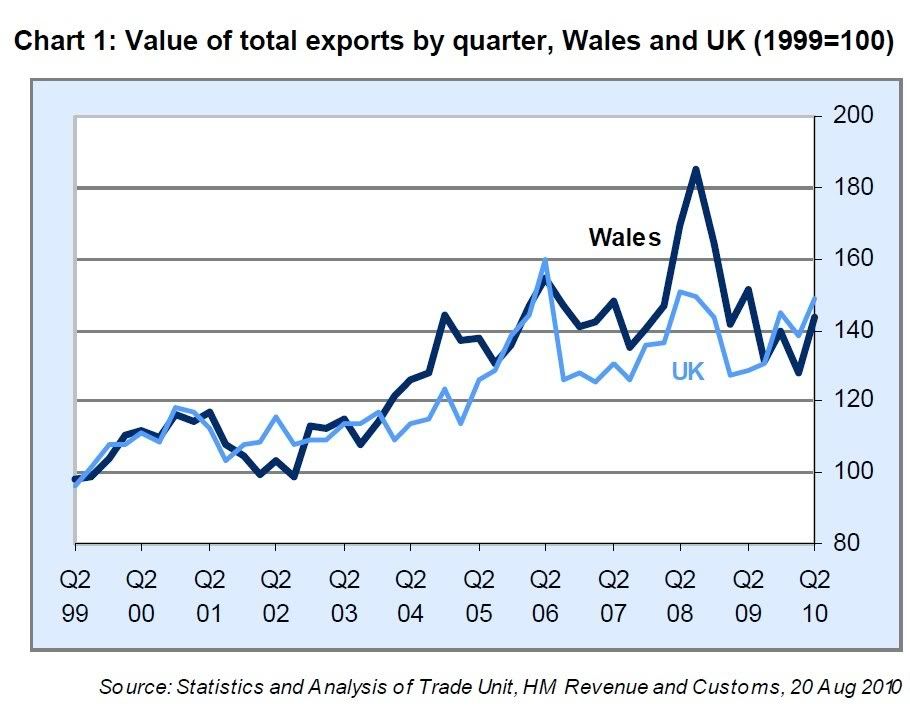Reading the news that the value of Welsh exports has dropped by £1.6bn in the last twelve months, and that the decrease is greater than in any other part of the UK, is not exactly the best way to start a Sunday morning. But it's always best to look at the source figures rather than rely on the headlines, and those figures are here:
Welsh Exports: Second Quarter 2010
The first thing that stands out is this graph on the front page. It is one instance where a picture really does paint a thousand words:

So yes, the downturn since the start of the banking collapse has been very severe for Wales; but for almost the whole of the decade since the Assembly was set up Wales has been very comfortably outperforming the UK as a whole. Right now, the line on the graph is a bit igam-ogam, but we are only fractionally behind the UK.
This is nothing to be complacent about, of course ... but nothing to beat ourselves up over, either. And if our strong growth in the last quarter is repeated again, we should be back on top in three months' time.


5 comments:
Wales had a trade surplus of around £2.7bn in 2009 according to this document (on page 17). This is very similar to successful smaller exporting nations in Europe like Denmark and exceeds a few oil-producing nations.
Hard facts rarely make for dramatic headlines or quick soundbites in Wales though, unless it's bad news of course........
Yes Owen, and thanks for the link. What's always struck me as significant from those figures is that the balance of payments deficits for the "richer" parts of the UK are huge compared with the "poorer" parts.
Taken together, the three south eastern regions of England import very nearly twice as much as they export. The only regions of England to have a surplus are the north east and north west. So England as a whole has a huge trade deficit; while Wales, Scotland and Northern Ireland each have healthy surpluses.
I have to admit that this seems counter-intuitive, and I don't really understand why it should be so. Do you, or does anyone else, have any insights to offer?
I realize that these figures exclude trade between regions of the UK, and I don't think any inter-regional trade figures are compiled. But it would be very interesting to know what the figures are, or if anyone has put together an unofficial estimate of what they might be.
Good old Welsh press, they love a negative comparison with England because they are obsessed with a false narrative of failure due to their psychology of colonialism.
I'm not an economist MH, but I think I can make a few reasoned observations.
SE England has a top-heavy reliance on the service/tertiary sector, and with that comes the distortion of the banking/financial City of London, where hundreds of billions of pounds move seemlessly across borders every single day.
Imports by definition include things that do not physically cross a border, just change owner to a resident of the region/nation. This includes services and even tourism. I imagine London (and the greater South East) being a global city and close to mainland Europe engages in this kind of "importing" on a scale far beyond Wales.
I'm not sure if this is relevant, but also think of where the major/busiest ports of the UK are. Many are clustered in the South and East of England; Felixstowe, Grimsby, Southampton, London itself plus the new one being built in the Thames Gateway. If a good is imported into a single region/nation of the UK via a port in that region then maybe it's simply accounted as such?
Of course we have a few large ports in Wales but no major container/goods port, or at least nothing on the scale as those I've mentioned.
Owen, I think the points you've made are good.
In the first instance the figures are for goods rather than services. The UK has for decades run a balance of payments loss. I can remember this first being an issue back in the sixties and seventies when the figures were gloomily announced on the news, but always qualified with "but if you take invisibles into account ... "
But I don't think ports are an issue, at least not directly. The figures are based on the location of the importer, not the point of entry. However the importers are more likely to be located closer to the points of entry to the UK for simple operational reasons. Then, on top of that, we get the same "head office distortion" as we get for all businesses, as I highlighted in this next post.
The very nature of goods is that they tend to eventually be disbursed from distribution centres and warehouses to shops and then on to the final customer. Therefore, so far as the regions and nations of the UK are concerned, the breakdown of export figures is useful (though subject to "head office distortion") but the breakdown of the import figures isn't so useful. The overall UK figures are useful, and they show just how much the UK has ceased to make things, and therefore how much the manufacturing base needs to be rebuilt.
I do think we should be looking to develop better port facilities in Wales, particularly because our side of this island should be a more convenient import location for goods coming from places other than mainland Europe.
Post a Comment